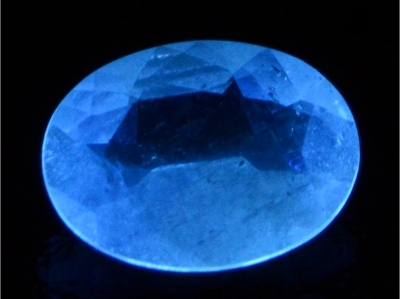Gemstone grade slightly-violetish-blue dumortierite from Madagascar
- Details
- Created: Monday, 10 December 2018 22:05
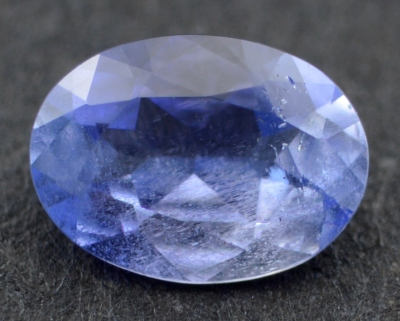 Figure 1. Facet grade 0.42 ct dumortierite from Madagascar.
Figure 1. Facet grade 0.42 ct dumortierite from Madagascar.| Shape | oval |
| Size | 5.9 x 4.3 x 2.2 mm |
| Color | slightly-violetish-blue |
| Lustre | vitreous |
| Weight | 0.42 ct |
| SG | - |
| RI | 1.673 - 1.690 |
| DR | 0.017 B- |
| Pleochroism | stong: blue / almost colorless (figure 2) |
| Polariscope / Conoscope | anisotropic: light/dark 4 times / 360°, conoscope not used |
| SWUV | very strong: bluish-white (figure 3) |
| LWUV | inert |
| Magnetic susceptibility N52 | diamagnetic |
| Chelsea filter | purplish |
Table 1. Observational and measured properties
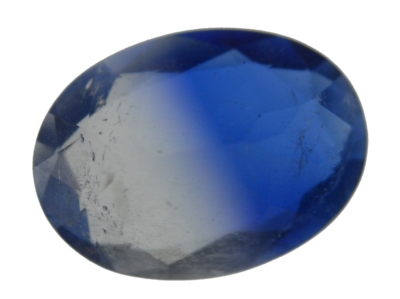 Figure 2. The colors of the strong pleochroism of the dumortierite
Figure 2. The colors of the strong pleochroism of the dumortieriteseen through the london dichroscope: blue and almost colorless.
This Malagasy dumortierite shows a very strong pleochroism as it can be observed in figure 2 using a london dischroscope. Even if the gemstone is biaxial and might have three pleochroism colors, only two colors are observed: almost colorless and strong blue. The material is strongly luminescent under the SWUV lamp although it is inert under the LWUV one, the bluish-white emission is shown in figure 3. Such luminescence is not so common and it is worth to be mentionned.
Infrared reflectance spectroscopy:
The IR reflectance spectrum (figure 4) was collected from the gemstone's table and shows a pattern spectrum which is consistent with dumortierite spectra. It is a quite complex spectrum mixing sillicate (800 - 1000 cm-1) and borate (1200 - 1400 cm-1) features.
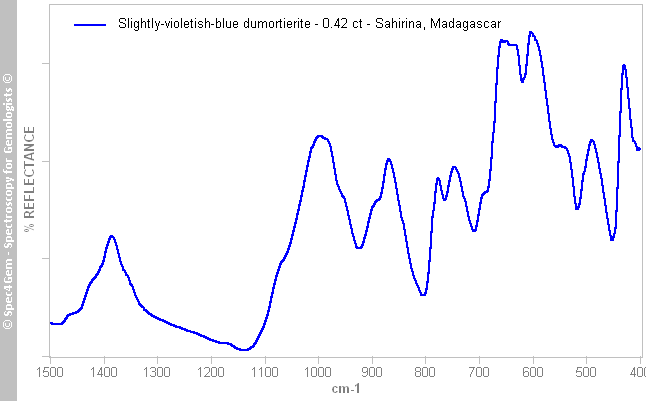 Figure 4. The IR reflectance spectrum is characteristic of dumortierite. It is a quite complex spectrum mixing sillicate (800 - 1000 cm-1) and borate (1200 - 1400 cm-1) features.
Figure 4. The IR reflectance spectrum is characteristic of dumortierite. It is a quite complex spectrum mixing sillicate (800 - 1000 cm-1) and borate (1200 - 1400 cm-1) features.UV-VIS-NIR spectroscopy:
The UV-Vis-NIR polarized spectra (figure 5) are very different from each other, the E||C spectrum shows a large band centered at 597 nm (with a perfect gaussian fit), the E_|_C spectrum is almost flat. The first one explains the slightly-violetish-blue color, and the second one the almost colorless 'color' of the strong pleochroism.
The 600 nm (597 nm here) is believed to be caused by the Fe2+-Fe3+ IVCT (Inter-Valence Charge Transfer)[4]. There is no evidence of the '500 nm' band linked to Fe2+-Ti4+ CT (Charge Transfer)[4], [5] which is generally responsible for the pink color.
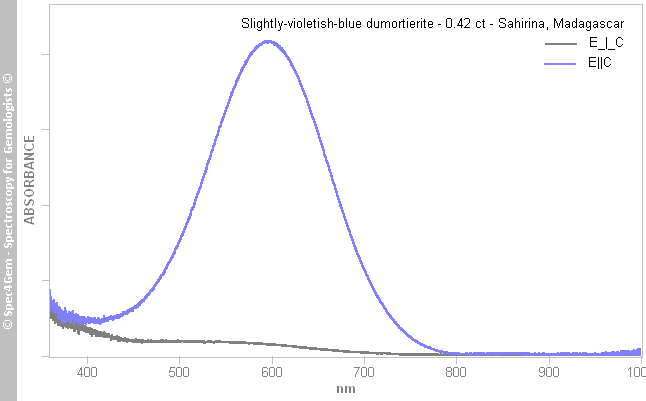 Figure 5. The UV-Vis-NIR polarized spectra are fully differ, the E||C spectrum shows a large band centered at 597 nm, the E_|_C spectrum is almost flat. The first one explains the slightly-violetish-blue color, and the second one the almost colorless 'color' of the strong pleochroism. The 600 nm is believed to be caused by the Fe2+-Fe3+ IVCT.
Figure 5. The UV-Vis-NIR polarized spectra are fully differ, the E||C spectrum shows a large band centered at 597 nm, the E_|_C spectrum is almost flat. The first one explains the slightly-violetish-blue color, and the second one the almost colorless 'color' of the strong pleochroism. The 600 nm is believed to be caused by the Fe2+-Fe3+ IVCT.Photoluminescence spectroscopy:
The photoluminescence spectra (figure 6) were collected with two sources: 405 and 254 nm. The 405 nm excitation source does not induce luminescence, this is similar to lack of reaction of the gemstone while exposed to the LWUV lamp. On the other hand, the 254 nm source induced a very strong bluish-white luminescence with a large emission centered at about 470 nm. This emmision is well-known and is attributed to TiO68- complexes replacing AlVI3+ in particular sites[6].
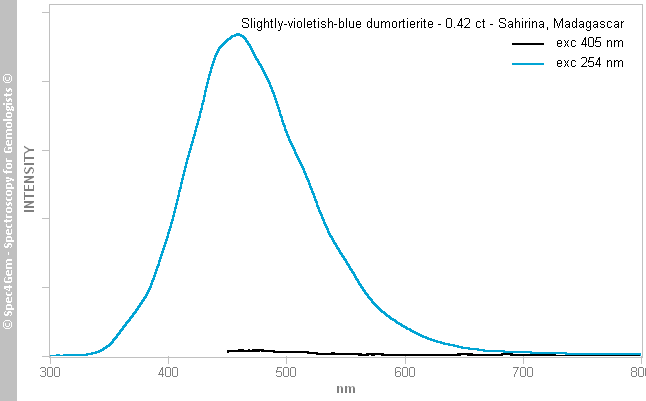 Figure 6. Photoluminescence spectra recorded with 405 and 254 nm sources. The 405 nm source does not induce any luminescence although the 254 nm one induces an amazingly strong bluish-white luminescence with the emission peaking around 470 nm related to TiO68- replacing AlVI3+.
Figure 6. Photoluminescence spectra recorded with 405 and 254 nm sources. The 405 nm source does not induce any luminescence although the 254 nm one induces an amazingly strong bluish-white luminescence with the emission peaking around 470 nm related to TiO68- replacing AlVI3+.Conclusion:
All data (classical gemology and spectroscopy) are consistent with dumortierite colored by Fe2+-Fe3+ IVCT showing a strong pleochroism. Its luminescence to SWUV indicates also the presence of TiO6 in the lattice. This Malagasy dumortierite gemstone is a great collector's stone but could also be a jewellery's stone since its hardness is higher than 7. Its rarity as a gemstone on its own and not only as an inclusion, usually in quartz[7],[8],[9], is really worth to be highlighted.
Similar material has recently been reported and described in the Journal Of Gemmolgy[10], it was identified by Raman spectroscopy.
[1] Some rare blue gemstones, J. Ostwald, Journal of Gemmology, 1964, volume 9, No.5, pp. 182-184
[2] Dumortierite from Sri Lanka, Gems & Gemology, 2000, Spring, pp. 62-63
[3] Transparent dumortierite and sapphirine from Tunduru, Tanzania, H. Hänni, Gems & Gemology, 2007, Winter, p. 379
[4] Dumortierite Visible Spectra - List of Visible Data Files on the Caltech Mineral Spectroscopy Server
[5] Fibrous nanoinclusions in massive rose quartz, Chi Ma, J.S. Goreva, G.R. Rossman, American Mineralogist, 2002, volume 87, pp. 269–276
[6] Luminescent Spectra of Minerals, Boris S. Gorobets and Alexandre A. Rogojine, Moscow, 2002, ISBN: 5901837053, p. 196
[7] Dumortierite-quartz rock presented as sapphire, G. Choudhary, Gems & Gemology, 2013, Spring, p. 59-60
[8] Dumortierite in rock crystal quartz, N. Renfro, Z. Sun and J. Koivula, Gems & Gemology, 2015, Spring, p. 100-102
[9] Dumortierite Inclusions in Quartz from Brazil, B.M. Laurs, Journal of Gemmology, 2015, volume 34, No.5, pp. 391-392
[10] Faceted Blue Dumortierite from Madagascar, E. Fritsch, A. Delaunay, S. Leblan, Journal of Gemmology, 2018, volume 36, No.2, pp. 94-96


